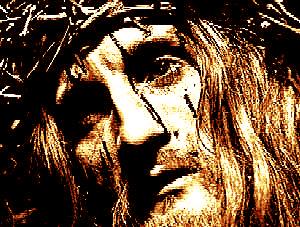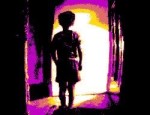Film Review

Le Vigan's personal morality notwithstanding, he was a remarkable actor and his portrayal of Christ is to be especially noted for its humility and humanity. Whereas previous screen depictions of Christ had emphasised Christ's divinity, Golgotha paints Christ in more human colours, and it is this which makes the film so poignant and involving, even for non-Christians. For believers and non-believers alike, the film is a moving indictment of man's inhumanity to man, and already we can discern Duvivier's intense pessimism concerning human nature, something that would could come to predominate in his later films.
We scarcely get more than a glimpse of Christ until halfway into the film. Until then, when we see him it is always from the back, or from a respectful distance. It is only after Jesus's arrest that the camera moves in closer and reveals him to us, and we are immediately struck by his apparent ordinariness. "Behold the Man" was the title under which the film was released in the United States, and this is what Duvivier shows us - Christ the man, not some fanciful halo-wearing deity. Without Christ's suffering, palpably conveyed by Le Vigan's understated performance, the Passion would be a meaningless charade, and this is where Duvivier's films triumphs over previous film renditions of the subject, even Cecil B. DeMille's The King of Kings (1927).
Although he had nothing like the resources that DeMille could command for his grand Hollywood epic, Duvivier achieves a comparable visual impact with some stylish camerawork and lavish sets swarming with hundreds of extras. The opening sequence has a long tracking shot that pans slowly across an authentic-looking recreation of the ancient city of Jerusalem. This was created by the American painter Ferdinand Earle, who had previously worked as art director on another Biblical epic, Fred Niblo's Ben-Hur: A Tale of the Christ (1925). It's a striking opening which has the effect of immersing the spectator in the setting of the ensuing drama, and Duvivier rarely demonstrated more visual flair than he does here, composing his shots for maximum dramatic effect whilst subtly referencing familiar religious paintings (including da Vinci's The Last Supper).
The quality of Duvivier's mise-en-scène is well-matched by the quality of the acting. In addition to Robert Le Vigan's inspired casting as Jesus, we have Jean Gabin (Duvivier's favourite actor of the period) as a surprisingly humane Pontius Pilate and Harry Baur towering over everything in sight as a suitably magisterial King Herod. Edwige Feuillère oozes compassion with her portrayal of Pilate's wife, and Lucas Gridoux evokes more sympathy than contempt as the tormented traitor Judas. The performances are excellent, although it is to be regretted that the mediocre script (credited to Duvivier himself) doesn't allow us to get too intimately involved with the characters. We see them from a distance, pretty much as the Gospels depict them, and our desire to comprehend their motives and behaviour is never entirely satisfied - this is the one obvious defect in an otherwise flawless production.
Here, for better or for worse, Duvivier appears to be far more preoccupied with grand cinematic spectacle than the kind of dramatic intimacy that ennobles his better known films of this period. Nowhere is this more evident than in the crucifixion scene, which is not only a highpoint in the director's oeuvre but also, arguably, one of the most visually stunning sequences of any French film of the 1930s - and much of the credit for this should go to Duvivier's gifted cinematographer Jules Kruger. There's a feverish, almost demonic power to this sequence - a sense that, as a frenzied storm breaks, spitting fury over humanity, the whole of creation is in uproar. The solemn calm that suddenly descends following Jesus's death is just as unnerving. In the innumerable subsequent film accounts of the Passion, no depiction of the crucifixion has quite the visceral impact of what Duvivier's Golgotha offers. For a fleeting moment you are convinced you have felt the wrath of God.
© James Travers 2015
The above content is owned by frenchfilms.org and must not be copied.
Film Synopsis
Judaea, during the reign of the Emperor Tiberius. When the self-proclaimed prophet Jesus Christ arrives in Jerusalem, he receives a rapturous welcome from the ordinary people of the city. The high priests of the Jewish faith are concerned by Jesus's popularity and, considering him to be a threat to their authority, conspire with the Romans to have him arrested and executed. In Canaan, knowing what is to come, Jesus gathers his disciples together and tells them that one of them will betray him. After his arrest, Jesus is mocked and scourged. The Roman prefect Pontius Pilate offers the people the choice of setting free the prophet Jesus or the insurrectionary Barabbas. They choose Barabbas...© James Travers
The above content is owned by frenchfilms.org and must not be copied.
Similar Films
Here are some other films you may enjoy watching:- Andrei Rublev (1966)
- Stavisky (1974)
- The Flesh and the Fiends (1960)
- Nicholas and Alexandra (1971)
- Becket (1964)
Other related links:
Film Credits
- Director: Julien Duvivier
- Script: Julien Duvivier
- Cinematographer: Jules Kruger
- Music: Jacques Ibert
- Cast: Harry Baur (Hérode), Jean Gabin (Ponce Pilate), Robert Le Vigan (Jésus Christ), Charles Granval (Caïphe), André Bacqué (Anne), Hubert Prélier (Pierre), Lucas Gridoux (Judas), Edmond Van Daële (Gerson), Edwige Feuillère (Claudia Procula), Juliette Verneuil (Marie), Marcel Chabrier (Joseph d'Arimathie), Georges Saillard (Un Sanhédrite), Marcel Carpentier (Le scribe), Victor Vina (Un Sanhédrite), François Viguier (Un Sanhédrite), Jean Forest (Jean), Philippe Hersent (Jacques), Maurice Lagrenée (Philippe), Paul Asselin (Mathieu), Robert Ozanne (Un centurion)
- Country: France
- Language: French
- Support: Black and White
- Runtime: 94 min
- Aka: Behold the Man
The very best sci-fi movies

The best French war films ever made

The best of American cinema
